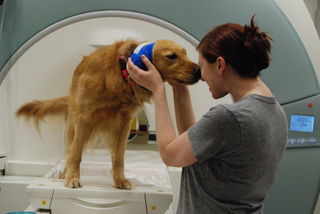Memory
Do Dogs Miss Us When We’re Gone?
Neuroscience shows that dogs have memories for humans.
Posted September 2, 2013 Reviewed by Ekua Hagan

I don’t take many vacations. It is not because I am a workaholic, but it is for the simple reason that I don’t like leaving the dogs behind. While reasonably well-behaved at home, the dogs become unhinged in novel environments and make for unpleasant travel companions. Plus, one of them gets carsick with such regularity 30 minutes into any drive that you could set a watch by his telltale retching. So when I do take a vacation, it is always twinged with a bit of guilt for leaving the dogs behind.
But do dogs really care?
Now two years into a project to train dogs to go into an MRI — fully awake — so that we can better understand how their brains work, I believe the answer is: Yes, dogs miss us when we’re gone.
The Dog Project began as a proof-of-concept. We simply wanted to determine if dogs could be trained to hold still enough to acquire quality fMRI data. We started with two dogs — Callie, my adopted feist, and McKenzie, a border collie. We trained them to recognize the meaning of two hand signals, one of which was associated with a food reward. The fMRI data clearly showed responses in the caudate nucleus to the “reward” hand signal. But that was just the beginning. For the story and more, see my latest book: What It's Like to Be a Dog.
Confident that we could collect fMRI data in awake dogs, we sought the help of Atlanta’s dog community. And they responded. With an outpouring of support, the team of MRI dogs has swelled to 15 and continues to grow. Now more than a cute dog trick, with a sizable cohort of subjects we can begin to answer real questions about canine cognition and emotion.
All of the dogs have completed the hand signal experiment. Mostly, we use this as their “final exam” to prove that they can do it. But it has also given us useful data on how variable the caudate response is between dogs. We almost have enough data to sort out breed differences and what makes for good therapy dogs.
The team has also gone through a second experiment to examine how the dogs’ brains respond to the scent of different members in their household. While in the MRI, we have presented to the dogs their own scent, the scent of familiar and strange humans, and the scent of familiar and strange dogs. We have not published these results yet, but I believe it is a smoking gun for canine emotions and proof that dogs really do love their humans, even more than their fellow canines.
Which brings me to the question of whether dogs love us when we’re gone. Even while doing these MRI scans, I have wondered about the dogs’ perception of time. Can dogs tell the difference between five minutes and five hours?
In 2011, Therese Rehn and Linda Keeling reported the effect of time left alone on dog behavior. They found that after 2 hours, dogs greeted their owners with more intensity than after 30 minutes of being left alone. However, there was no difference between 2 and 4 hours. This suggests that dogs can tell the difference between 30 minutes and 2 hours, but beyond that it is unclear.
Humans don’t need a clock to know how much time has passed. We can mark time by the relative height of the sun during the day and the moon at night, the temperature, the sounds of birds in the morning and owls at night.
Clearly, these abilities are within the dog’s skill set too. Animals also have internal circadian rhythms. These cycles are partly coupled to the day/night cycle but also free run. Cortisol and melatonin, for example, rise and fall in regularity, providing an internal clock. And a dog can likely tell the passage of time by the distension of his bladder and the hunger in his belly.
But what about days? Can dogs tell the difference between one day and seven?
I do not know of any direct evidence for this, but we can speculate two possible mechanisms by which dogs could tell the passage of long periods of time. The first is fairly simple and based on associative memory. Through repeated pairings, a dog learns that his owner is associated with good stuff: food, play, social bonding. This is the basis of positive training. If these events are removed, it is possible that the associations will begin to decay. Psychologists call this “extinction.” In rats, this is a slow process, often requiring hundreds of repetitions without positive reinforcement. And even when extinguished, prior associations are easily reestablished, suggesting that these associative memories never really go away.
The second mechanism is more sophisticated and would require that dogs have what is called “episodic memory.” This is a memory for events. Endel Tulving once wrote that episodic memory is unique to humans, but a growing body of data suggests otherwise.
In 1998, Nicola Clayton and Anthony Dickinson showed that scrub jays could remember where they had cached food based on the perishability of the items. After a long delay, the birds returned to locations with non-perishable foodstuffs. In 2005, Madeline Eacott, Alexander Easton, and Ann Zinkivskay showed that rats could recall objects by context and location. This “what-where-which” skill is evidence for episodic-like memories. In 2012, Wenyi Zhou, Andrea Hohmann, and Jonathan Crystal further tested rats’ ability to encode the context of where food is located: “To test episodic memory, we gave rats the opportunity to incidentally encode the presence or absence of food and unexpectedly asked them to report about the recent event.” Moreover, the researchers traced this ability to the rat hippocampus by temporarily inactivating the hippocampus with lidocaine and eliminating the rats’ episodic memory.
If rats have evidence of episodic memory, then it is a sure bet that dogs do too. I hope to soon test this with our team of MRI dogs. But none of this makes me feel any better about taking a vacation.
Facebook image: Jaromir Chalabala/Shutterstock




